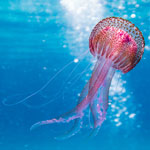World Jellyfish Day Date in the current year: November 3, 2026
 World Jellyfish Day, sometimes referred to as simply Jellyfish Day, is celebrated annually on November 3. It was established in honor of amazing sea creatures that have existed for at least 500 million years – much longer than humans.
World Jellyfish Day, sometimes referred to as simply Jellyfish Day, is celebrated annually on November 3. It was established in honor of amazing sea creatures that have existed for at least 500 million years – much longer than humans.Despite their name, jellyfish aren’t actually fish. The term “jellyfish” refers to the free-swimming medusa phase of certain species of the subphylum Medusozoa. The life cycle of medusozoans involves four main stages: egg, planula (larval stage), polyp, and medusa. The medusa stage is the adult stage; a polyp becomes a medusa once it reaches sexual maturity.
The term “medusa” was borrowed from Greek mythology, where it is the name of a monstrous creature with venomous snakes in place of hair. Medusae and similar marine animals have been referred to as jellyfish in English since the late 18th century. They received this name for their gelatinous body.
The umbrella-shaped body of a jellyfish is called a bell. It is made up of transparent matter called mesoglea, which is 95% water but also contains fibrous proteins and other substances. The mesoglea is sandwiched between the epidermis (skin) and the gastrodermis (a membrane surrounding the gastrovascular cavity).
Jellyfish also have tentacles armed with stinging cells that allow them to defend themselves from predators and capture prey. Large jellyfish can sting swimmers; the effects of a jellyfish sting can range from mild discomfort to extreme pain and even death. However, only some jellyfish species’ stings are known to cause a serious adverse reaction in humans. One of the most venomous jellyfish is the sea wasp.
The true jellyfish (the class Scyphozoa of the subphylum Medusozoa) are exclusively marine animals that can be found in both shallow and deep waters worldwide. However, some hydrozoans that have a similar appearance to scyphozoans but are smaller in size inhabit freshwater.
Jellyfish have been part of the human diet in some regions of the world for a long time. They are considered a delicacy in China, Japan, Korea, and some other Asian countries. Jellyfish are also harvested as a source of collagen, used in scientific research, and displayed in public aquariums around the world.
The origins of World Jellyfish Day are unclear, but it has been observed since at least 2014. The holiday was most likely established by a group of marine biologists or simply nature enthusiasts who wanted to celebrate one of the most amazing creatures that can be found in our seas and oceans. World Jellyfish Day takes place in the springtime in the Southern Hemisphere, marking the beginning of the season when jellyfish begin their migration to the Northern Hemisphere.
There are many ways to celebrate World Jellyfish Day. You can check out a jellyfish exhibit at your local zoo or aquarium, learn interesting facts about jellyfish by reading a book or watching a documentary about these unique invertebrates, and share photos or videos of jellyfish on social media with the hashtags #WorldJellyfishDay and #JellyfishDay to spread the word about the holiday.
- Category
- International Observances, Ecological Observances
- Tags
- World Jellyfish Day, international observances, environmental observances, jellyfish, medusa